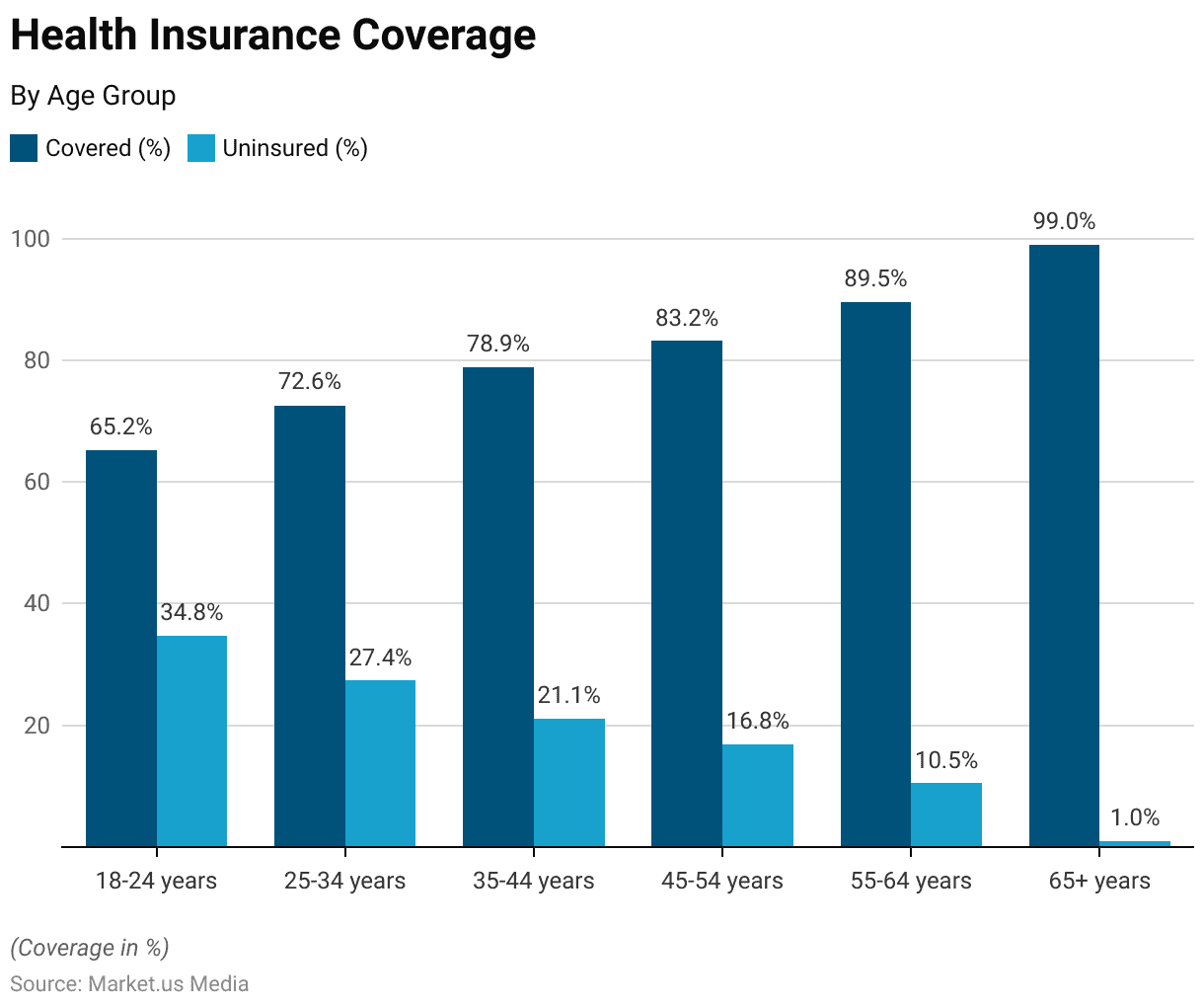The insurance industry has long been a bedrock of financial security, offering peace of mind to millions worldwide. But behind its perceived stability lies a dynamic, ever-evolving market. 2025 was a milestone year for the sector, with significant shifts driven by technology, changing consumer behavior, and regulatory transformations. As we look ahead, understanding key statistics can give us a better sense of where the industry is headed.
Editor’s Choice
- The global insurance market reached a total premium volume of $8.1 trillion in 2025, reflecting a 5.3% year-over-year increase, driven by health, cyber, and climate-related risk coverage.
- North America continues to lead the industry, generating 41.7% of global premiums in 2025, supported by strong life, property, and commercial insurance segments.
- Cyber insurance premiums rose by 28.5% in 2025, as companies faced heightened risks from ransomware, data breaches, and AI-generated fraud, marking it as one of the fastest-growing insurance segments globally.
- Insurtech investment reached $15.8 billion globally in 2025, as insurers accelerated adoption of AI underwriting, blockchain claims automation, and digital-first customer experiences.
- In the U.S., the life insurance sector grew by 6.6% in new premiums in 2025, with demand rising for hybrid life-insurance products, flexible annuities, and digitally accessible plans.
- Climate change risk is now a top priority, with 74% of global insurers incorporating climate risk data and predictive modeling into their underwriting frameworks as of 2025.
- Global health insurance payouts surged to $1.95 trillion in 2025, driven by long-COVID care, chronic illness management, and preventive care policies fueled by digital health platforms and employer plans.
Workforce Statistics in the Insurance Industry
- The global insurance industry employed approximately 5.67 million people in 2025, reflecting a 5% increase year-over-year, largely fueled by digital expansion, AI integration, and customer service demand.
- In the United States, women now comprise 62.1% of the insurance workforce in 2025, continuing to lead in claims processing, customer service, and administrative functions, while also growing in underwriting and compliance roles.
- Technology-related roles within insurance companies expanded by 14.2% in 2025, as demand surged for AI engineers, cybersecurity experts, and digital transformation specialists across all business units.
- Remote work in the insurance industry increased, with 45% of employees working from home at least part-time.

- In Europe, the insurance workforce held steady at around 985,000 employees, with significant growth in digital reskilling, ESG reporting, and cross-border regulatory compliance roles.
- The average salary in the U.S. insurance industry reached $78,200 in 2025, with actuaries, data scientists, and cyber risk officers among the top earners, often exceeding $120,000 annually.
- Diversity and inclusion (D&I) initiatives continue to expand, with 84% of top U.S. insurers now running targeted recruitment and mentorship programs to improve racial, ethnic, and gender representation in mid- and senior-level roles.
Women in Insurance
- In 2025, women now hold 33.8% of senior management positions in the global insurance industry, driven by leadership pipeline programs and gender equity initiatives.
- Female-led insurance firms outperformed their male-led counterparts by an average of 9.1% in profitability in 2025, highlighting the value of diverse leadership styles and inclusive cultures.
- In the UK, 48.2% of the insurance workforce is now female in 2025, with senior leadership participation increasing in underwriting, legal, and finance departments.
- Women in STEM roles within the insurance sector grew by 11.7% in 2025, particularly in data analytics, actuarial science, and AI/machine learning for risk modeling.
- Women of color remain underrepresented in executive roles in the U.S. insurance industry, holding only 6.8% of C-suite positions in 2025, prompting calls for intersectional diversity programs.
- Flexible work policies targeted at supporting women, including enhanced parental leave, hybrid work models, and mentorship support, expanded by 17.5% across top global insurers in 2025.
- Female entrepreneurs in insurtech increased by 24.3% in 2025, with women launching AI-powered claims platforms, embedded insurance solutions, and niche digital brokerages in underserved markets.
Consumer Behavior and Insurance Product Trends
- In 2025, 81% of insurance buyers conducted their research online, and 68.5% completed their purchase digitally, highlighting the continued shift toward self-service platforms and digital-first engagement.
- Millennials (ages 27–42) now represent the largest demographic for life insurance, accounting for 44.3% of new policy sales, driven by rising financial literacy and the use of mobile-first advisory tools.
- The demand for on-demand insurance, including travel, gadget, and pet coverage, grew by 16.7% in 2025, reflecting consumer preference for flexible, event-triggered, and usage-based plans.
- Telematics insurance adoption rose by 21.5% in 2025, especially among drivers under 35, with insurers offering up to 30% premium savings based on driving behavior tracked via apps and devices.
- The pet insurance market expanded by 19.2% in 2025, driven by the continued rise in pet ownership, tele-vet services, and bundled wellness options, pushing the U.S. market past $4.1 billion.
- Wellness-based health insurance policies, offering premium discounts for achieving fitness, diet, or preventive care goals, grew by 13.6% in 2025, supported by integrations with wearables and digital health apps.
- Sustainability-focused insurance products saw a 10.4% increase in adoption in 2025, with policies rewarding eco-friendly practices, such as electric vehicle usage, green building upgrades, and climate-resilient construction, especially popular in Europe and North America.

Life Insurance Industry
- The global life insurance market grew by 6.2% in 2025, with total premiums reaching approximately $3.02 trillion, driven by digital adoption, aging populations, and post-pandemic financial awareness.
- Asia-Pacific remained the top growth region, contributing 46.5% of global life premiums in 2025, led by China, India, and Japan, where demand for retirement-linked and hybrid products surged.
- In the United States, life insurance sales increased by 6.8% in 2025, supported by a strong rise in whole-life, indexed universal, and term-life policy enrollments.
- Term life insurance made up 43.2% of all life insurance policies sold in 2025, reflecting ongoing consumer interest in affordable, flexible coverage, especially among Millennials and Gen Z.
- Online life insurance sales jumped by 18.9% in 2025, fueled by mobile-first platforms, instant underwriting, and a shift toward digital-first onboarding among younger policyholders.
- The average coverage amount for life insurance policies in the U.S. climbed to $483,000 in 2025, a 3.9% increase from the previous year, as consumers sought greater financial protection amid inflation concerns.
- Middle-income families in the U.S. remained the fastest-growing segment, with a 10.7% increase in policyholders in 2025, driven by affordable premium structures and family-focused benefit plans.
Life Insurance Claims and Age-Based Trends
- Global life insurance claims payouts increased by 6.1% in 2025, totaling approximately $1.72 trillion, driven by aging populations and broader critical illness coverage adoption.
- The average age of policyholders at the time of claim rose slightly to 62.8 years, highlighting continued demand for retirement and end-of-life planning solutions.
- Millennials (ages 27–42) now represent 31.4% of life insurance policyholders, with an 8.2% increase in new policies sold to this age group in 2025, largely due to digital onboarding and financial literacy outreach.
- Seniors aged 60+ accounted for 61.7% of all life insurance claims in 2025, reinforcing the growing importance of long-term care riders, hybrid products, and final expense coverage.
- Accidental death claims rose by 4.6% in 2025, especially among policyholders under 45, reflecting shifts in urban mobility, outdoor activity trends, and increased personal accident coverage awareness.
- The addition of critical illness riders to life policies grew by 10.3% in 2025, driven by rising concerns around heart disease, cancer, and early detection benefits embedded into modern policies.
- Digital claims processing expanded further, with 78.5% of life insurance claims in the U.S. handled online in 2025, reducing processing time by an average of 30%, thanks to AI verification tools and e-signature systems.
Global Insurance Market Growth Forecast
- The forecast for 2025 anticipates the market will reach $7,711.6 billion, reflecting strong year-over-year growth.
- Looking ahead to 2026, the global insurance market is expected to climb to $8,398.11 billion, nearly a $2.5 trillion increase from 2022 levels.

Car/Auto Insurance Statistics
- The U.S. auto insurance market reached $301.2 billion in premiums in 2025, showing a 4.6% annual growth, driven by rising vehicle costs, urban traffic, and premium recalibrations.
- Telematics-based auto insurance adoption grew by 21.4% in 2025, especially among drivers under 35, as insurers offered up to 30% discounts based on safe driving behavior tracked via mobile apps and vehicle sensors.
- Electric vehicle (EV) insurance premiums remained 16% to 22% higher than traditional vehicles in 2025, due to specialized parts, advanced tech systems, and limited repair networks.
- Accident claims rose by 3.5% in 2025, largely attributed to increased post-pandemic road usage, distracted driving, and higher collision rates in urban zones.
- Comprehensive auto insurance claims linked to natural disasters surged by 9.3% in 2025, as extreme weather events like hailstorms, floods, and wildfires became more frequent across multiple U.S. regions.
- Liability insurance claims made up 61.5% of total auto insurance payouts in 2025, reinforcing the need for adequate bodily injury and property damage coverage amid rising litigation.
- The average annual auto insurance premium in the U.S. climbed to $1,865 in 2025, a 4.8% increase from the previous year, with significant premium hikes noted in California, Florida, and Texas.
Business Insurance Statistics
- Commercial property insurance premiums increased by 7.9% in 2025, driven by heightened demand in manufacturing, logistics, and climate-exposed sectors, with total U.S. premiums surpassing $79 billion.
- Cyber insurance premiums saw a continued surge of 24.6% growth in 2025, as ransomware attacks and data breaches pushed demand for standalone cyber policies among mid-sized and large enterprises.
- Liability insurance claims for businesses reached $248.7 billion in 2025, marking a 5.8% increase year-over-year due to rising litigation costs and third-party injury claims.
- Workers’ compensation insurance premiums in the U.S. remained steady at $45.5 billion in 2025, with growth tempered by automation and improved workplace safety in sectors like retail, warehousing, and transport.
- Business interruption insurance claims declined by 2.5% in 2025, as companies improved supply chain resilience, remote continuity planning, and adopted parametric policies.
- Construction sector insurance premiums rose by 9.8% in 2025, driven by elevated project risk, inflation in building materials, and coverage demand for modular construction and infrastructure projects.
- Directors and Officers (D&O) insurance premiums increased by 6.4% in 2025, due to a rise in regulatory scrutiny, ESG-related litigation, and shareholder activism in both the U.S. and European markets.
Health Insurance Coverage by Age Group
- Among 18–24-year-olds, only 65.2% are insured, leaving a high 34.8% uninsured, the highest uninsured rate among all groups.
- The 25–34 age group shows a slight improvement, with 72.6% covered and 27.4% uninsured, still reflecting significant coverage gaps.
- For 35–44-year-olds, 78.9% have insurance, while 21.1% remain uninsured, indicating growing coverage with age.
- Coverage increases in the 45–54 age group, with 83.2% insured and 16.8% uninsured, continuing the upward trend.
- In the 55–64 bracket, 89.5% are covered and only 10.5% are uninsured, showing strong pre-retirement insurance adoption.
- Seniors aged 65+ years have the highest coverage rate at 99.0%, with just 1.0% uninsured, thanks to near-universal programs like Medicare.

Impact of Technology and AI on Insurance
- Artificial intelligence (AI) adoption in the insurance industry grew by 17.8% in 2025, with accelerated integration into claims processing, fraud detection, and AI-powered chatbots across both life and property & casualty segments.
- Insurtech startups attracted $16.2 billion in global funding in 2025, as insurers expanded digital transformation initiatives and partnerships with AI, IoT, and embedded insurance platforms.
- Blockchain adoption in insurance contracts, especially for parametric insurance and smart contracts, increased by 10.5% in 2025, improving policy transparency, claims automation, and data immutability.
- Chatbots and virtual assistants handled 38.6% of total customer service interactions in 2025, resulting in a 15% reduction in call center staffing costs and an enhanced 24/7 user experience.
- AI-driven underwriting reduced application processing times by 28% in 2025, while improving risk scoring accuracy through real-time data inputs from telematics, wearables, and credit behavior.
- Data analytics usage grew by 13.2%, with insurers using predictive modeling to launch hyper-personalized policies, optimize pricing strategies, and improve customer retention.
- Automation in claims management led to a 22% reduction in settlement times in 2025, with average claim resolution in under 4 days, driving customer satisfaction scores up by 11% year-over-year.
Top U.S. Insurance Companies by Annual Ad Spending
- GEICO leads the pack with a massive $2,160 million spent on advertising, showing its aggressive brand visibility strategy.
- Progressive follows closely, investing $1,950 million annually in ads to maintain a strong market presence.
- State Farm allocates $1,170 million to advertising, securing its position among the top three insurers by ad spend.
- Allstate rounds out the list with $929 million in ad expenses, reflecting a more measured but still substantial marketing approach.

Recent Developments in Insurance Regulation
- U.S. Climate Risk Reporting: California’s SB 261 mandates that insurers disclose climate-related financial risks by January 1, 2026, covering fiscal year 2025 data. This initiative aims to enhance transparency regarding insurers’ exposure to environmental risks.
- Solvency II Reforms in Europe: The European Union published amendments to the Solvency II Directive on January 8, 2025. Member States have until January 30, 2027, to transpose these changes, which aim to refine capital requirements and risk sensitivity, promoting long-term sustainable economic growth.
- Enhanced Cybersecurity Regulations: The U.S. Securities and Exchange Commission (SEC) implemented new rules requiring public companies, including insurers, to disclose material cybersecurity incidents within four days of determining their materiality. This move addresses heightened cyber risks and aims to improve transparency in cybersecurity preparedness.
- Anti-Discrimination Measures in Insurance Pricing: In 2025, regulatory scrutiny intensified over the use of AI in insurance pricing models. The focus is on ensuring that these models do not result in unfair discrimination, particularly concerning protected classes. Insurers are urged to evaluate their algorithms to prevent discriminatory outcomes.
- Strengthened Consumer Protection Policies: The Washington State Insurance Commissioner highlighted consumer protection and transparency as top priorities for 2025. Efforts are underway to ensure that insurance products are clearly presented to consumers, enhancing their understanding and decision-making capabilities.
- EU Insurance Distribution Directive (IDD) Amendments: The EU’s IDD has been updated to streamline cross-border insurance sales. Insurance distributors are now required to report specific information annually to their home Member State’s competent authority, facilitating greater competition and regulatory oversight across member states.
- Increased Regulatory Oversight of Insurtech Firms: In 2025, many governments introduced regulatory sandboxes, allowing Insurtech startups to test new solutions in controlled environments. These initiatives aim to foster innovation while ensuring that digital insurance providers operate within established regulatory frameworks.
Conclusion
The insurance industry demonstrates resilience and adaptability in the face of global challenges. With significant strides in digital transformation, climate risk adaptation, and consumer-centric product offerings, the sector continues to evolve. As we move forward, technology, sustainability, and regulatory frameworks will be key drivers shaping the industry’s future.



































































